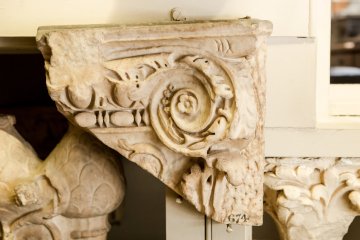Explore Collections


You are here:
CollectionsOnline
/
Fragment of a Roman Composite pilaster capital
Browse
Fragment of a Roman Composite pilaster capital
c.100 AD
Late Flavian (69-96 AD) or, more likely, early Trajanic (98-117 AD)
Late Flavian (69-96 AD) or, more likely, early Trajanic (98-117 AD)
Pentelic marble
Height: 32cm, maximum
Width: 33cm
Thickness: 10cm
Width: 33cm
Thickness: 10cm
Museum number: M674
On display: Dome Area
All spaces are in No. 13 Lincoln's Inn Fields unless identified as in No. 12, Soane's first house.
For tours https://www.soane.org/your-visit
Curatorial note
This fragment was carved in relief from a rough-surfaced panel background, a portion of which appears at the right. The abacus and enrichment to the bead and reel moulding (consisting of flattened, profiled acanthus leaf leading into the volute scroll, and egg and dart) are carved in a concave segment; below the bead and reel there are traces of scrolled acanthus foliage.
This piece is Roman work and judging from the bead and reel and egg and tongue, it is late Flavian or, more likely, of an early Trajanic date. The details of the foliate carving in the volute, the carving of the egg, and the treatment of bead and reel all point to this pilaster capital being the product of the same workshop which produced the capitals forming the structure of the ancient building into which the Church of S. Maria in Cosmedin, Rome, is built 1.
For drawings of a number of 'Oscan' lapidary marks from Pompeii, see Gusman2
1 Photo Anderson 4748; Canina, Edifizi di Roma; II, pl. XLIII, 'Tempio di Cerere e Proserpina', fig.2, etc.
2 P. Gusman, Pompei: The City, its Life and Art, trans. F. Simmonds and M. Jourdain, London, 1900, p. 36.
This piece is Roman work and judging from the bead and reel and egg and tongue, it is late Flavian or, more likely, of an early Trajanic date. The details of the foliate carving in the volute, the carving of the egg, and the treatment of bead and reel all point to this pilaster capital being the product of the same workshop which produced the capitals forming the structure of the ancient building into which the Church of S. Maria in Cosmedin, Rome, is built 1.
For drawings of a number of 'Oscan' lapidary marks from Pompeii, see Gusman2
1 Photo Anderson 4748; Canina, Edifizi di Roma; II, pl. XLIII, 'Tempio di Cerere e Proserpina', fig.2, etc.
2 P. Gusman, Pompei: The City, its Life and Art, trans. F. Simmonds and M. Jourdain, London, 1900, p. 36.
Possibly purchased by Soane at Robert Adam Sale (Christie's), 22 May 1818, Lot. 88, A composite capital for a pilaster, the foliage pierced to receive ornaments of bronze or other metal, and 3 fragments of an antique frieze, very fine, £3.0.0.
Soane collections online is being continually updated. If you wish to find out more or if you have any further information about this object please contact us: worksofart@soane.org.uk


